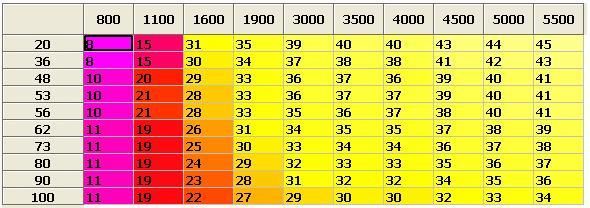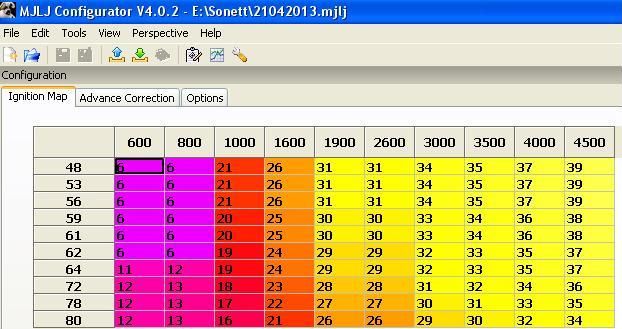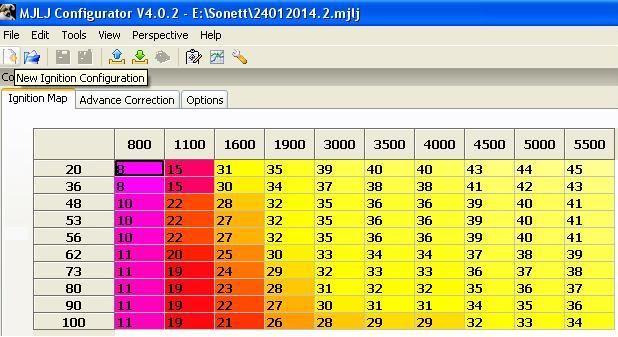| Author |  Topic Topic  |
Borstlap
V4 Fanatic
  
Norway
334 Posts |  Posted - 10 Jun 2014 : 21:04:05 Posted - 10 Jun 2014 : 21:04:05  
| Hi James,
As a picture says more than 1000 word I took some screenshots to make the explanation a bit more lively  . .
First a picture of the standard map I programmed in on the 96:

As is shown here, ignition timing depends on load (in this case vacuum in the inlet manifold) and rpm.
The MJ has an Auxiliary Input that can be used to influence timing. Voltage is between 0 and 5 volts, going up in steps of 0.02 volts. The extra window shows the connection between each step (ADC voltage) and the measured voltage (Voltage). The column Scaled Value can be filled out with anything you like. Often a coolant temp sensor is used, just as in my case. When you know the connection between temperature in degrees Celsius or Fahrenheit you could fill these values out, but as I don't know I didn't bother to do so. To the left is the row with 10 bins where corrections can be programmed. Both bin values and corrections can be filled out after own preference. I found out that normal operation temperature equals a value of about 112 units. When the value goes up to 116 units the needle of the dashboard gauge begins to creep up. MJ has four ouputs that can be programmed to either conduct or not conduct at a set value of rpm, load or Aux Input (I will make a screenshot and post that later). What I saw is that when the fan is activated is that the Aux value goes up for a short while (it takes some time before the cooled coolant fluid reaches the sensor) and then starts to go down again. The fan stops at a value well under 116, somewhere around 110.

When an engine is under operational temperature it can do with some extra advance in order to burn a colder mixture. When the engine gets too warm it can do with less advance, especially at idle. The same was done on the last model years of the 96 where there was a gizmo installed on the thermostat housing that operated a valve that regulated vacuum advance. When coolant temperature went up the valve opened, switching from a vacuum point under the throttle plate to a point above. This killed any vacuum advance, making the engine run slower and maybe burning less mixture. Biggest influence will be at idle; I saw that idle went down when advance got down. To decrease advance does influence performance of the engine, but preventing an engine from overheating is worth the small sacrifice (I've once been stuck in traffic with an engine beginning to overheat and a cabin heater at full power  ). ).
Alex |  |
|
James Ranaldi
V4 Guru
    
United Kingdom
1475 Posts |  Posted - 10 Jun 2014 : 22:09:34 Posted - 10 Jun 2014 : 22:09:34  
| Thanks Alex,
I think I understood the logic there 
Very interesting.
Thanks
1968 V4, LHD
1984 99 GL
1992 900i Convertible |  |
|
Dirtbiker
V4 Guru
    
United Kingdom
1061 Posts |  Posted - 12 Jun 2014 : 09:11:43 Posted - 12 Jun 2014 : 09:11:43  
| Hi Alex,
This is really interesting - keep the updates coming!
Cheers |  |
|
Derek
V4 Guru
    
United Kingdom
2192 Posts |  Posted - 12 Jun 2014 : 15:04:05 Posted - 12 Jun 2014 : 15:04:05  
| | What does the 20 - 100 list on the left represent? with most standard engines advance usually max's out around 3500 and some people find that near max revs the engine can make more power by reducing the advance by a degree or two. Any comments on that? |  |
|
Borstlap
V4 Fanatic
  
Norway
334 Posts |  Posted - 12 Jun 2014 : 16:57:54 Posted - 12 Jun 2014 : 16:57:54  
| The 20-100 list is pressure in the manifold measured in absolute KPa. 100 KPa is ambient air pressure (= 1 bar), 0 KPa is total vacuum. I started the map by trying to stay as close as possible to the mechanical advance curve of the dizzy. Then it is just to use mechanical advance only at WOT and adding vacuum advance at various levels of vacuum.
By extending the range between minimum and maximum advance you can improve performance. It has been a year since I started with making and adjusting maps for the Sonett and if I remember correctly I made som downward adjusments at higher load. In addition I added a degree or two at higher revs and I can't help feeling that the engine's response to that is positive. I will take a look at the old maps I saved and post them, just to see the difference. The map that is up here is for the 1700 engine in the 96 and should have (according to an official Ford manual)less advance than a 1500 engine.
Alex |  |
|
Borstlap
V4 Fanatic
  
Norway
334 Posts |  Posted - 12 Jun 2014 : 17:52:21 Posted - 12 Jun 2014 : 17:52:21  
| So here they are, first the map I started with:

And here the most recent one:

I found out after the first test drive that I needed to extend the range both towards lower and higher KPa values. The engine pulls quite a vacuum going downhill without moving the throttle and at WOT pressure sometimes may creep up to 102KPa; ram-air in a confined engine compartment  ? So at WOT advance went down. I haven't been at the dyno, but I have the feeling that the changes improved performance. The improvement compared to the old setup with the dizzy is dramatically: no more hesitation at low speed when the throttle is opened up, markedly better responce between 2800 and 4000rpm and even stronger pulling at high revs. ? So at WOT advance went down. I haven't been at the dyno, but I have the feeling that the changes improved performance. The improvement compared to the old setup with the dizzy is dramatically: no more hesitation at low speed when the throttle is opened up, markedly better responce between 2800 and 4000rpm and even stronger pulling at high revs.
Alex |  |
|
Borstlap
V4 Fanatic
  
Norway
334 Posts |  Posted - 11 Jul 2014 : 22:27:29 Posted - 11 Jul 2014 : 22:27:29  
| The Megajolt project is coming to a close. One of the last issues to try was hooking up the electric fan to one of the output channels. The four available output channels start or stop conducting to ground when triggered by a chosen value of rpm, engine load or Aux input value. During a calibration session I picked a value where the needle of the dashboard coolant temperature gauge started to get over the horizontal position. This became the triggering point for the cooling fan. Another nice option of the MJ is that advance can be influenced by Aux input values. As Aux input is in my case regulated by the coolant temp sensor I added a degree or two advance for coolant temps under normal and put in a degree retard for temps over normal; same principle as the mechanical device that was used in the latest model years.
http://youtu.be/_IfKgYiMd7A
I spliced the Aux Input channel of the MJ into the wire that runs between the coolant temp gauge in the dashboard and the sensor. For security I put a diode in the connection to the MJ; I didn't want to take the risk of blowing up something with the 12 volts from the dashboard gauge into the 5 volts earth side of the MJ.
All this testing resulted into the first drive on own power in more than 20 years 
http://youtu.be/u3dNYtB_Pzs
though for the wrong reasons  . All the testing was done with the front wheels off the ground so that I was able to have the wheels spinning and get some load on the engine. Unfortunately the right hand side inner CV dust boot got a tear and flying grease began to muck up the engine compartment and even the bonnet of the Sonett. As the car was parked with the right hand side to the wall of the container I had to get it out and turn it. Only these few metres made me eager to get the car roadworthy again so instead of only swapping the dust boot I decided to start the battle of the rust removal again. First out is the front wheel suspension. So maybe I'll start another project thread here about an opal green 96 and its long way to roadworthiness . All the testing was done with the front wheels off the ground so that I was able to have the wheels spinning and get some load on the engine. Unfortunately the right hand side inner CV dust boot got a tear and flying grease began to muck up the engine compartment and even the bonnet of the Sonett. As the car was parked with the right hand side to the wall of the container I had to get it out and turn it. Only these few metres made me eager to get the car roadworthy again so instead of only swapping the dust boot I decided to start the battle of the rust removal again. First out is the front wheel suspension. So maybe I'll start another project thread here about an opal green 96 and its long way to roadworthiness 
Alex |  |
|
Borstlap
V4 Fanatic
  
Norway
334 Posts |  Posted - 22 Aug 2015 : 23:24:18 Posted - 22 Aug 2015 : 23:24:18  
| Some progress in the project again. I had the nose off in July and decided to install electric cooling fans. A guy on the Swedish Saabclub website inspired me by having installed two 10' fans on his Sonett. He put both in front of the radiator. I prefer to have them behind but in order to get both there means that the bearing of the mechanical fan has to be removed and that (in my case) the trigger wheel and sensor for the Megajolt had to be repositioned. As this was too much work for now I installed one fan in front and one behind.


Current for the fans is drawn from the B+ connection at the alternator, secured by a 25 Amp fuse. The switching relay is tucked in nicely between the voltage regulator and the coil. The additional wiring goes partly through the extra flexible tube I put in place for the required MJ loom.

I started programming the activation threshold value as used on the 96, but this was too low; the fans kept going while the needle of the coolant temperature gauge had dropped a bit under horizontal. A small adjustmend solved the problem. Works like a charm . . .
Alex |
Edited by - Borstlap on 24 Aug 2015 22:32:15 |  |
|
 Topic Topic  | |

